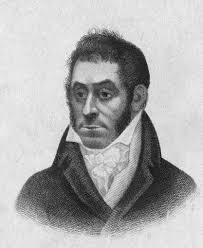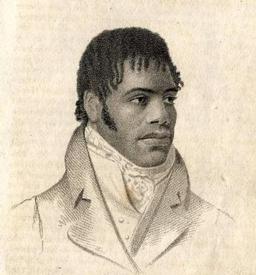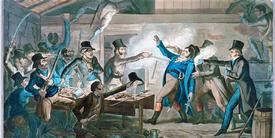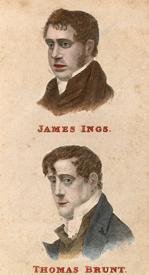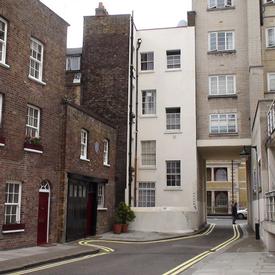Arthur Thistlewood was a striking looking man, standing at about five feet ten (fairly tall for his time), with sunken eyes and a prominent jaw that was lined on both sides with thick sideburns. Those sunken eyes were fixed on the ground on the afternoon of Wednesday 23rd February 1820, as he tried to look inconspicuous among the people going about their business near Edgware Road, north London. Turning onto to Cato Street, he took a last look around him to make sure he was not being watched, and entered a small building where he proceeded to the loft.
Arthur Thistlewood (wikipedia)
When Thistlewood emerged from the building that night it would not be in the leisurely manner he had entered it, and those sunken eyes would be darting around the street in search of an escape route. He had been watched that afternoon, very closely, by government authorities. They had sat and watched as Thistlewood and his companions entered the small building on Cato Street one by one, and they had caught them off guard in the night. In the struggle that followed Thistlewood killed one of the government men and managed to escape the scene, but would be captured the following day and destined for the gallows with his friends.
What were Thistlewood and his gang up to that afternoon? Why were they under the close watch of the authorities? Because they were revolutionaries, who planned to murder the Prime Minister and his entire cabinet that very night. The plan was audacious and could have worked if they had not recruited one man too many: among the plotters was a government agent who had been relaying the plot back to his masters all along.
Britain on edge in 1820
Victory at the Battle of Waterloo in 1815 should have heralded a new era of peace and prosperity for Britain, but economic and political tensions remained prominent. The economy spiralled into recession, providing fertile ground for revolutionary sentiment. It was only 30 years since the French revolution and 40 years since the American revolution, and though Britain had officially been opposed to both those events there was still enough rebellious fervour in the air to make a British revolution a possibility. In 1819 a demonstration for political rights at St. Peter’s field in Manchester had been violently crushed by the army, an event that was ironically christened as the ‘Peterloo’ massacre and led to a widespread sense among common people that the British system and establishment, which so many normal British people had fought to preserve during the Napoleonic wars, was not on their side.
Enter Arthur Thistlewood. The illegitimate son of a successful Lincolnshire farmer, born in 1774, he had followed a curious route from rural nobody to devoted revolutionary. Having left his unsatisfying job as a land surveyor, he joined the army briefly but was radicalised by a trip to the US in 1794. He returned to England with a burning admiration for the American revolution and a sense that it was his duty to overthrow the British government. After unsuccessfully trying his hand at managing a farm, he was heavily involved in a plot in December 1816 to seize the Bank of England and the Tower of London, and when this was foiled he tried to emigrate to the US with his wife, Susan Wilkinson, and their daughter (this was his second wife – his first wife, Jane Worsley, died in childbirth in 1797). He was arrested as he boarded the ship and tried for treason, but caught a lucky break when his defence counsel was able to show that the main witness against him had a long criminal history himself and was therefore unreliable. Acquitted of treason, Thistlewood was a free man but under constant surveillance.
The plot
Would Arthur Thistlewood take advantage of his good fortune and retire to a more quiet life? Not a bit of it. He was absolutely committed to his cause, though he was not entirely what his cause was, aside from the violent overthrow of the government. While his acquaintances in radical circles, such as Henry ‘Orator’ Hunt, had a clearer idea of what they wanted to achieve – political representation, basic rights, to be achieved as peacefully as possible – Thistlewood would speak of the overthrowing the government but seemed unsure of what he would do next.
In any case, he was in good company in his revolutionary sentiment. He was involved in the gathering at St Peter’s field in August 1819, in which Henry Hunt tried to speak before the army blundered their way through the crowd, and organised a hero’s welcome for Hunt in London soon after. However, despite his outward respect for Hunt the events at ‘Peterloo’ only seem to have made him more sure than ever that Hunt’s idea of respectable protest was redundant – as far as Thistlewood was concerned, violence was the only way to achieve change.
William Davidson (working class movement library)
By late 1819, Thistlewood had organised a group of like-minded companions: Tom Brunt, a London shoe-maker, Richard Tidd, another shoe-maker, James Ings, a butcher, and William Davidson, a mixed-race illegitimate son of the former Attorney-General of Jamaica. In an atmosphere that was further poisoned by Prime Minister Robert Jenkinson’s oppressive measures in the wake of the Peterloo massacre, they forged a brutal plan that involved murdering the Prime Minister and his entire cabinet, including the hero of Waterloo, the Duke of Wellington, the next time they were gathered together. They would then parade their severed heads for all of London to see and establish a council to rule the country. The fact that they all moved in radical circles and in the same echo chambers seems to have counted against them, as they were all genuinely convinced that the British people would spontaneously rise up and support the coup. The plan was outlandish and not properly thought through, but it was not impossible that its first phase – the murders – would work.
However, to implement the plan they needed more men, and in bringing in more men they left themselves open to infiltration. George Edwards, a government agent who had been watching Thistlewood and his group, worked his way into their good graces and was made privy to the plan. Unbeknownst to the gang, their plot was already doomed.
On Tuesday 22nd February 1820, an alert member of the group spotted a small announcement in one of the London newspapers that the Prime Minister and the cabinet were due to dine at Lord Harrowby’s house in Grosvenor Square, less than a twenty minute walk from the gang’s base in Cato Street, the following night. The plot was set in motion, and the gang agreed to gather at their base the following afternoon.
Of course, George Edwards told the authorities straight away, and the building was put under surveillance. During the following afternoon, the gang – which by now numbered nearly 30 men – arrived one by one at Cato Street. Just after 7 o’clock that evening, the authorities were satisfied that the main culprits were in the building and made their way across the street.
Thistlewood and his men were gathered in the loft, and had scarcely had a chance to hand out their weapons – including pistols, sabres and grenades – among each other when they were surprised by the door being sprung open and authorities streaming in. Thistlewood used his sabre to kill Richard Smithers, a government man, and managed to escape in the ensuing struggle. A few others managed to escape, and each ran for their lives in separate directions. The rest of the gang were forced to halt their resistance as more and more authorities surrounded the building.
Thistlewood strikes Richard Smithers as government agents storm the loft (Marble Arch London)
Execution
Thistlewood did not return home that night, but neither did he flee London as he probably should have. Instead, he rented a room in the eastern part of the city. By morning, the newspapers had alerted the city of the previous night’s events and the Home Secretary had offered a reward of £1,000 – an astronomical sum – for information leading to Thistlewood’s capture. He was easily traced to his temporary lodgings and was arrested just after 9 o’clock on the morning of 24th February. He was asleep when authorities entered his room.
Before they went to trial, the ringleaders were brought before the highest ranking members of the cabinet – the very men they had intended to kill. They were all unapologetic about what they had planned, with James Ings declaring that ‘death would be a pleasure to me.’ While they awaited trial, they were imprisoned in the Tower of London.
This unapologetic attitude continued at their trial in April, where Thistlewood proudly admitted his guilt and used his time in the spotlight to drive home his points, namely that the government was denying liberty to the British people while plundering their wealth at the same time. He was sentenced to death, along with Ings, Tidd, Davidson and Brunt. Another five members of the gang were sentenced to transportation to Australia.
Just before 8 o’clock on the morning of 1st May 1820, the five condemned men were brought to the scaffold outside Newgate prison in London, in front of an estimated crowd of 80,000 people. In some ways they were lucky, because the sentence of hanging, drawing and quartering, which had been the standard English punishment for treason and involved having one’s insides removed while still alive, had been abolished just seven years previously. Instead, they would die simply by hanging. All five faced their fate bravely, with Ings in particular showing resilience to the end, singing an anthem popular with radicals at the time. He was shut up by Arthur Thistlewood’s last ever words: ‘do be quiet Ings – we can die without all this noise.’ When they were dead, their heads were cut off and displayed before the crowd, who laughed heartily when the hangman dropped Thistlewood’s head. Observers were disgusted by this reaction, and soon after the idea of public executions would be questioned for the first time.
James Ings and Tom Brunt went to the gallows (science photo library)
Arthur Thistlewood and his gang may have been intent on a horrific act, but to understand their motives one has to imagine the Britain they lived in. It was a country teetering on the edge of revolution, with uprisings sprouting up across the land and an oppressive government brutally exerting its authority. In their minds, it was the government who were the aggressors against the British people, so it was the government who would suffer the consequences of what they saw as the inevitable backlash. However, their mistake (aside from being infiltrated by a government agent) was to assume that everyone felt the same as they did and set off on a course that had no real aim. While French and American revolutionaries had achieved change through uniting different factions of revolutionary thought to produce a mass movement and had benefitted from extraordinary leaders and distinct aims, the Cato Street gang decided to implement their own dangerous plan and assume everyone would follow them, and were led by a man who had no long-term vision. They have been derided as daft and murderous by some, and praised as romantic and righteous by others. In fact, both assessments are probably true.
The small building in Cato Street looks anonymous in the modern day, but was the scene of a violent confrontation in 1820 (londonremembers.com)
PODCAST - The Podcast version of this story is available on apple and spotify!
https://podcasts.apple.com/gb/podcast/the-cato-street-conspiracy/id1550458439?i=1000510245378
https://open.spotify.com/episode/5njjr5fGCFoRFVxQl0PYeK?si=m2rvYGVaQb2VgidV_xy2Sg
Like this article? Explore the blog for more great content, and donate here! We need your help to keep the blog going!
https://www.buymeacoffee.com/tomMOH
Acknowledgements
The Ministry of History is not an academic source. Our pieces are written by writers who have been keen students of history for years and are well versed in, and influenced by, countless other writers and works. For this article specifically our sources have included:
'The Cato street conspiracy', article published by nationalarchives.gov.uk
'The Cato street conspiracy', article by Alan Smith, published by History Today (1953)
'To kill the cabinet: the Cato street conspiracy', article published by historyextra.com

.jpeg)
